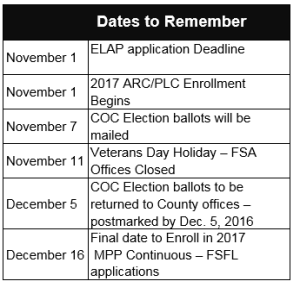|
 WHO CAN VOTE WHO CAN VOTE
Agricultural producers of legal voting age may be eligible to
vote if they participate or cooperate in any FSA program. A
person who is not of legal voting age but supervises and
conducts the farming operations of an entire farm also may be
eligible to vote. Members of American Indian tribes holding
agricultural land are eligible to vote if voting requirements
are met. More information about voting eligibility requirements
can be found in the FSA fact sheet titled “FSA County Committee
Election - Eligibility to Vote and Hold Office as a County
Committee Member” http://www.fsa.usda.gov/
news-room/county-committee-elections/index.
Producers may contact their local FSA county office for more
information. To find your local FSA county office, visit
http://offices.usda.gov.
USDA Issues Safety-Net Payments to Farmers in Response to
2015 Market Downturn
The U.S. Department of Agriculture (USDA) announced that
beginning today, many of the 1.7 million farms that enrolled in
either the Agriculture Risk Coverage (ARC) or Price Loss
Coverage (PLC) programs will receive safety-net payments due to
market downturns during the 2015 crop year.

This fall, USDA will be making more than $7 billion in payments
under the ARC-County and PLC programs to assist participating
producers, which will account for over 10 percent of USDA’s
projected 2016 net farm income. These payments will help provide
reassurance to America’s farm families, who are standing strong
against low commodity prices compounded by unfavorable growing
conditions in many parts of the country.
Unlike the old direct payment program, which issued payments
during both weak and strong market conditions, the 2014 Farm
Bill authorized the ARC-PLC safety net to trigger and provide
financial assistance only when decreases in revenues or crop
prices, respectively, occur. The ARC and PLC programs primarily
allow producers to continue to produce for the market by making
payments on a percentage of historical base production, limiting
the impact on production decisions.
Nationwide, producers enrolled 96 percent of soybean base acres,
91 percent of corn base acres and 66 percent of wheat base acres
in the ARC-County coverage option. Producers enrolled 99 percent
of long grain rice and peanut base acres and 94 percent of
medium grain rice base acres in the PLC option. Overall, 76
percent of participating farm base acres are enrolled in
ARC-County, 23 percent in PLC and one percent in ARC-Individual.
For other program information including frequently asked
questions, visit www.fsa.usda.gov/arc-plc.
Payments are made to producers who enrolled base acres of
barley, corn, grain sorghum, lentils, oats, peanuts, dry peas,
soybeans, wheat and canola. In the upcoming months, payments
will be announced after marketing year average prices are
published by USDA’s National Agricultural Statistics Service for
the remaining covered commodities. These include long and medium
grain rice (except for temperate Japonica rice), which will be
announced in November, remaining oilseeds and chickpeas, which
will be announced in December, and temperate Japonica rice,
which will be announced in early February 2017. Upland cotton is
no longer a covered commodity.
The Budget Control Act of 2011, passed by Congress, requires
USDA to reduce 2015 ARC and PLC payments by 6.8 percent. For
more information, producers are encouraged to visit their local
Farm Service Agency (FSA) office. To find a local FSA office,
visit http://offices.usda.gov.
USDA Offers New Loans for Portable Farm Storage and Handling
Equipment
USDA’s Farm Service Agency (FSA) will provide a new financing
option to help farmers purchase portable storage and handling
equipment through the Farm Storage Facility Loan (FSFL) program.
The loans, which now include a smaller microloan option with
lower down payments, are designed to help producers, including
new, small and mid-sized producers, grow their businesses and
markets. The FSFL program allows producers of eligible
commodities to obtain low-interest financing to build or upgrade
farm storage and handling facilities.

The program also offers a new “microloan” option, which allows
applicants seeking less than $50,000 to qualify for a reduced
down payment of five percent and no requirement to provide three
years of production history, with CCC providing a loan for the
remaining 95 percent of the net cost of the eligible FSFL
equipment. Farms and ranches of all sizes are eligible. The
microloan option is expected to be of particular benefit to
smaller farms and ranches, and specialty crop producers who may
not have access to commercial storage or on-farm storage after
harvest. These producers can invest in equipment like conveyers,
scales or refrigeration units and trucks that can store
commodities before delivering them to markets. FSFL microloans
can also be used to finance wash and pack equipment used
post-harvest, before a commodity is placed in cold storage.
Producers do not need to demonstrate the lack of commercial
credit availability to apply for FSFL’s.
Larger farming and ranching operations, that may not be able to
participate in the new “microloan” option, may apply for the
traditional, larger FSFL’s with the maximum principal amount for
each loan through FSFL of $500,000.00. Participants are required
to provide a down payment of 15 percent, with CCC providing a
loan for the remaining 85 percent of the net cost of the
eligible storage facility and permanent drying and handling
equipment. Additional security is required for poured-cement
open-bunker silos, renewable biomass facilities, cold storage
facilities, hay barns and for all loans exceeding $100,000.00.
FSFL loan terms of 3, 5, 7, 10 or 12 years are available
depending on the amount of the loan. Interest rates for each
term rate may be different and are based on the rate which CCC
borrows from the Treasury Department.
Earlier this year, FSA significantly expanded the list of
commodities eligible for FSFL. Eligible commodities now include
aquaculture; floriculture; fruits (including nuts) and
vegetables; corn, grain sorghum, rice, oilseeds, oats, wheat,
triticale, spelt, buckwheat, lentils, chickpeas, dry peas sugar,
barley, rye, hay, honey, hops, maple sap, unprocessed meat and
poultry, eggs, milk, cheese, butter, yogurt and renewable
biomass.
Applications for FSFL must be submitted to the FSA county office
that maintains the farm's records. The FSFL application must be
approved before: purchasing the FSFL equipment, beginning any
excavation or site preparation, accepting delivery of FSFL
equipment, beginning installation or construction.
To learn more about Farm Storage Facility Loans, visit
www.fsa.usda.gov/pricesupport or contact a local FSA county
office. To find your local FSA county office, visit
http://offices.usda.gov.

Offers to Re-Enroll CRP Acres Expiring on September 30, 2017
are Being Accepted Now
Participants with CRP contracts expiring on September 30, 2017
are encouraged to contact their local FSA county offices now to
determine if all or a portion of their expiring acreage is
eligible for re-enrollment in CRP continuous signup 50.
The 2014 Farm Bill requires that beginning October 1, 2016, no
more than 24 million acres can be enrolled in CRP. Although the
USDA, Farm Service Agency (FSA) is close to the 24 million acre
national statutory cap, contracts on 2.5 million acres of land
previously enrolled in CRP will expire from the program on
September 30, 2017.
FSA county offices are continuing to accept offers from
producers seeking to enroll lands in the program. In order to
manage the record demand for CRP acres, producers submitting CRP
offers for any continuous enrollment will have the option to
request a contract effective date of October 1, 2017 or pending
availability of acres, request a contract with an effective date
during fiscal year (FY) 2017.
Participants in CRP establish long-term, resource-conserving
plant species, such as approved grasses or trees (known as
“covers”) to control soil erosion, improve water quality and
develop wildlife habitat on marginally productive agricultural
lands. In return, FSA provides participants with rental payments
and cost-share assistance. Contract duration is between 10 and
15 years. The long-term goal of the program is to re-establish
native plant species on marginal agricultural lands for the
primary purpose of preventing soil erosion and improving water
quality and related benefits of reducing loss of wildlife
habitat.
Farmers to Receive Documentation of USDA Services
Farm Service Agency (FSA) reminds agricultural producers that
FSA provides a receipt to customers who request or receive
assistance or information on FSA programs.
The 2014 Farm Bill requires a customer receipt to be issued for
any agricultural program assistance requested from FSA, the
Natural Resources Conservation Service (NRCS) and Rural
Development (RD). Receipts include the date, summary of the
visit and any agricultural information, program and/or loan
assistance provided to an individual or entity. Electronic
receipts for acreage reports will begin on August 1, 2016.
A service is any information, program or loan assistance
provided whether through a visit, email, fax or letter.

Farm
Reconstitutions
When changes in farm
ownership or operation take place, a farm reconstitution is
necessary. The reconstitution — or recon — is the process of
combining or dividing farms or tracts of land based on the
farming operation.
The following are the
different methods used when doing a farm recon.
Estate Method —
the division of bases, allotments and quotas for a parent farm
among heirs in settling an estate;
Designation of Landowner Method - may
be used when (1) part of a farm is sold or ownership is
transferred; (2) an entire farm is sold to two or more persons;
(3) farm ownership is transferred to two or more persons; (4)
part of a tract is sold or ownership is transferred; (5) a tract
is sold to two or more persons; or (6) tract ownership is
transferred to two or more persons. In order to use this method
the land sold must have been owned for at least three years, or
a waiver granted, and the buyer and seller must sign a
Memorandum of Understanding;
DCP Cropland Method —
the division of bases in the same proportion that the DCP
cropland for each resulting tract relates to the DCP cropland on
the parent tract;
Default Method —
the division of bases for a parent farm with each tract
maintaining the bases attributed to the tract level when the
reconstitution is initiated in the system.
Maintaining the Quality of Loaned Grain
Bins are ideally designed to hold a level volume of grain. When
bins are overfilled and grain is heaped up, airflow is hindered
and the chance of spoilage increases.
Producers who take out marketing assistance loans and use the
farm-stored grain as collateral should remember that they are
responsible for maintaining the quality of the grain through the
term of the loan.
Farm Loan Graduation Reminder
FSA Direct Loans are considered a temporary source of credit
that is available to producers who do not meet normal
underwriting criteria for commercial banks.
FSA periodically conducts Direct Loan graduation reviews to
determine a borrower’s ability to graduate to commercial credit.
If the borrower’s financial condition has improved to a point
where they can refinance their debt with commercial credit, they
will be asked to obtain other financing and partially or fully
pay off their FSA debt.
[to top of second column] |

By the end of a producer’s operating cycle, the Agency will send
a letter requesting a current balance sheet, actual financial
performance and a projected farm budget. The borrower has 30
days to return the required financial documents. This
information will be used to evaluate the borrower’s potential
for refinancing to commercial credit.
If a borrower meets local underwriting criteria, FSA will send
the borrower’s name, loan type, balance sheet and projected cash
flow to commercial lenders. The borrower will be notified when
loan information is sent to local lenders.
If any lenders are interested in refinancing the borrower’s
loan, FSA will send the borrower a letter with a list of lenders
that are interested in refinancing the loan. The borrower must
contact the lenders and complete an application for commercial
credit within 30 calendar days.
If a commercial lender rejects the borrower, the borrower must
obtain written evidence that specifies the reasons for rejection
and submit to their local FSA farm loan office.
If a borrower fails to provide the requested financial
information or to graduate, FSA will notify the borrower of
noncompliance, FSA’s intent to accelerate the loan, and appeal
rights.
Marketing Assistance Loans Available for 2016 Crops
The 2014 Farm Bill authorized 2014-2018 crop year Marketing
Assistance Loans (MALs) and Loan Deficiency Payments (LDPs).
MALs provide financing and marketing assistance for 2016 crop
wheat, and other commodities such as feed grains, soybeans and
other oilseeds, pulse crops, wool and honey. MALs provide
producers interim financing after harvest to help them meet cash
flow needs without having to sell their commodities when market
prices are typically at harvest-time lows.
Illinois FSA county offices are now accepting requests for 2016
crop wheat, oats, barley and honey MALs and LDPs for eligible
commodities after harvest. As 2016 crop harvest begins, Illinois
FSA county offices are accepting requests for 2016 fall
harvested crops; corn and soybeans.
A producer who is eligible to obtain an MAL, but agrees to forgo
the loan, may obtain an LDP if such a payment is available.

To be eligible for an MAL or an LDP, producers must have a
beneficial interest in the commodity, in addition to other
requirements. A producer retains beneficial interest when
control of and title to the commodity is maintained. For an LDP,
the producer must retain beneficial interest in the commodity
from the time of planting through the date the producer filed
Form CCC-633EZ (page 1) in the FSA County Office. For more
information, producers should contact their local FSA county
office or view the LDP Fact Sheet.
Disaster Set-Aside (DSA) Program
FSA borrowers with farms located in designated primary or
contiguous disaster areas who are unable to make their scheduled
FSA loan payments should consider the Disaster Set-Aside (DSA)
program.
DSA is available to producers who suffered losses as a result of
a natural disaster and is intended to relieve immediate and
temporary financial stress. FSA is authorized to consider
setting aside the portion of a payment/s needed for the
operation to continue on a viable scale.
Borrowers must have at least two years left on the term of their
loan in order to qualify.
Borrowers have eight months from the date of the disaster
designation to submit a complete application. The application
must include a written request for DSA signed by all parties
liable for the debt along with production records and financial
history for the operating year in which the disaster occurred.
FSA may request additional information from the borrower in
order to determine eligibility.
All farm loans must be current or less than 90 days past due at
the time the DSA application is complete. Borrowers may not set
aside more than one installment on each loan.
The amount set-aside, including interest accrued on the
principal portion of the set-aside, is due on or before the
final due date of the loan.
For more information, contact your local FSA farm loan office.
USDA
Reminds Producers of Nov.
1 ELAP
Application Deadline
Eligible livestock,
honeybee, and farm-raised fish producers who experienced losses due
to disease, adverse weather or other conditions, such as blizzards
and floods, not covered by other agricultural disaster assistance
programs, have untilNov.
1, 2016, to submit an application and notice of loss
under the Emergency Assistance for Livestock, Honeybees and
Farm-Raised Fish Program (ELAP).

Eligible livestock losses
include; loss of purchased feed and/or mechanically harvested feed
due to an eligible adverse weather event, additional cost of
transporting water because of an eligible drought and additional
cost associated with gathering livestock to treat for cattle tick
fever.
Eligible honeybee losses
include loss of purchased feed due to an eligible adverse weather
event, cost of additional feed purchased above normal quantities due
to an eligible adverse weather condition, colony losses in excess of
normal mortality due to an eligible weather event or loss condition,
including CCD, and hive losses due to eligible adverse weather.
Producers who suffer
eligible livestock, honeybee, or farm-raised fish losses from
October 1, 2015 to September 30, 2016 must file:
-
A
notice of loss the earlier of 30 calendar days of when the loss
is apparent or by November
1, 2016
-
An
application for payment by November
1, 2016
The following ELAP Fact
Sheets (by topic) are available online:
-
ELAP
for Farm-Raised Fish Fact Sheet
-
ELAP
for Livestock Fact Sheet
-
ELAP
for Honeybees Fact Sheet
USDA Announces Safety Net Assistance for Milk Producers Due
to Tightening Dairy Margins
USDA today announced approximately $11.2 million in financial
assistance to American dairy producers enrolled in the 2016
Margin Protection Program for Dairy (MPP-Dairy). The payment
rate for May/June 2016 will be the largest since the program
began in 2014. The narrowing margin between milk prices and the
cost of feed triggered the payments, as provided for by the 2014
Farm Bill.
Dairy producers should evaluate their enrollment options for
2017, as the enrollment period ends Dec. 16, 2016.
Dairy producers who enrolled at the $6 through $8 margin trigger
coverage level will receive MPP payments. MPP-Dairy payments are
triggered when the national average margin (the difference
between the price of milk and the cost of feed) falls below a
level of coverage selected by the dairy producer, ranging from
$4 to $8, for a specified consecutive two-month period. The
national average margin for the May/June 2016 two-month
consecutive period is $5.76277 per hundred weight (cwt.).

To learn more about the Margin Protection Program for dairy,
visit the Farm Service Agency (FSA) online at www.fsa.usda.gov/dairy
or stop by a local FSA office. Producers may visit
www.fsa.usda.gov/mpptool to calculate the best levels of
coverage for their dairy operation. To find an FSA office near
you, visit
http://offices.usda.gov.


Illinois Farm Service Agency
3500 Wabash Ave.
Springfield, IL 62711
Phone: 217-241-6600 ext.2
Fax: 855-800-1760
www.fsa.usda.gov/xx
State Executive Director:
Scherrie V. Giamanco
State Committee:
Jill Appell - Chairperson
Brenda Hill - Member
Jerry Jimenez - Member
Joyce Matthews - Member
Gordon Stine - Member
Executive Officer:
Rick Graden
Administrative Officer:
Dan Puccetti
Division Chiefs:
Doug Bailey
Jeff Koch
Stan Wilson
To find contact information for your local office go to
www.fsa.usda.gov/il
USDA is an equal opportunity
provider, employer and lender. To file a complaint of
discrimination, write: USDA, Office of the Assistant Secretary for
Civil Rights, Office of Adjudication, 1400 Independence Ave., SW,
Washington, DC 20250-9410 or call (866) 632-9992 (Toll-free Customer
Service), (800) 877-8339 (Local or Federal relay), (866) 377-8642
(Relay voice users).
 |